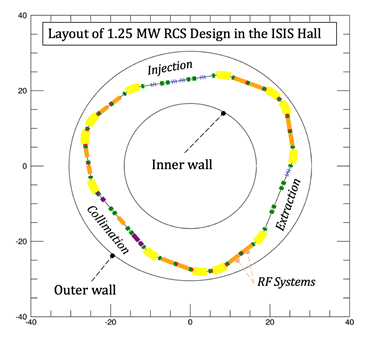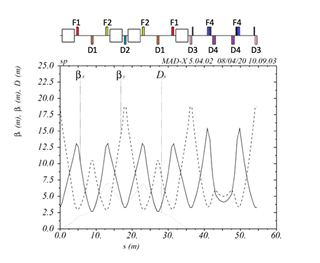A comprehensive study is under
way to define the best configuration for a next generation, world class neutron
source, ISIS II. The design is being lead by users, in consultation with target
and neutronic experts as well as accelerator physicists. Accelerator studies
include the possibility of using novel FFA (fixed field alternating gradient)
accelerator technology, as well as more conventional RCS (rapid cycling
synchrotron) and AR (accumulator ring) designs [1]. The present baseline
specification is to supply 1.25 MW proton beam at 1.2 GeV, split between 1 MW,
40 Hz target and 0.25 MW, 10 Hz target.
The synchrotron group is leading
the work on the latter, conventional designs [2]. Whilst the RCS and AR rings
are conventional, the demands for the design stretch key parameters beyond
current state of the art. In addition, desire to reduce costs and optimise beam
properties, is driving studies to achieve lower loss and thus improve
understanding of high intensity beams.
The project requires designs of a
number of machine options, to allow detailed comparison and identification of
the best choice. This includes design of an RCS and AR that is constrained to
fit in the existing ISIS Hall (thus reducing cost), and also a relatively
unconstrained “green field” design.
The main parameters, lattice and
layout of the present working design for the RCS that fits in the ISIS hall are
shown in Table 1 and Figure 1. Further details may be found in [1, 2 refs].
![]()
![]()



Figure 1: Schematic
Layout of ISIS II RCS (left) and sector lattice (right)
Main areas of work required for
the designs are: lattice optimisation, longitudinal dynamics, transverse
dynamics studies, 3D dynamics simulation and optimisation, injection straight
design, foil optimisation, collimation design, extraction and assessment of
dominant losses due to instabilities and space charge. Further details on the
R&D that underpins much of this work are outlined in the Accelerator
Physics R&D section.
[1] J B Lagrange et al, Progress on Design Studies for the
ISIS II Upgrade, http://jacow.org/ipac2019/papers/tupts068.pdf
[2] C M Warsop et al, Studies for Major ISIS Upgrades via
Conventional RCS and Accumulators Ring Designs http://jacow.org/ipac2018/papers/tupal058.pdf
